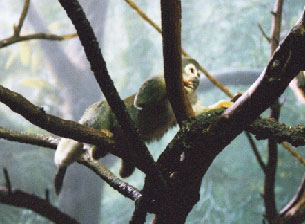The average body mass for adult males range between 700 to 1100 grams, and for females the range is between 500 to 750 grams. The common squirrel monkey has a short digestive tract indicative of insectivory. The cheek teeth have large cusps assists the common squirrel monkey in eating insects (Fleagle, 1988). Males have longer canines than the females (Fleagle, 1988). The tail of the common squirrel monkey is prehensile in infants but the adults lose this ability. The body has a long trunk and hindlimbs and also possesses a long tail (Fleagle, 1988).
RANGE:
The common squirrel monkey is found in the countries of Bolivia, Brazil, Colombia, Ecuador, French Guiana, Guyana, Peru, Suriname, and Venezuela; a small population has been introduced to Southern Florida. This species prefers rainforests, and can adapt to different kinds of rainforests. The common squirrel monkey prefers to live in the middle canopy, but will occasionally come to the ground or go up into the high canopy.



